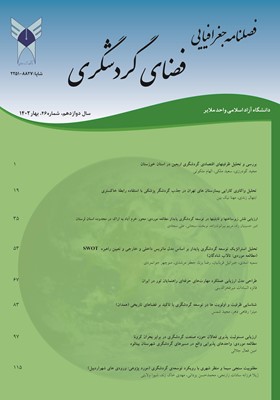ارزیابی نقش زیرساختها و قابلیتها در توسعه گردشگری پایدار مطالعه موردی : محور خرم آباد به اراک در محدوده استان لرستان
محورهای موضوعی : مربوط به گردشگریامیر حسینیان راد 1 * , مریم بیرانوندزاده 2 , نوبخت سبحانی 3 , علی سجادی 4
1 - استادیار گروه جغرافیا، دانشگاه لرستان، خرم آباد، ایران
2 - دکتری جغرافیا و برنامه ریزی شهری، پژوهشگر جهاد دانشگاهی استان لرستان، خرم آباد، ایران
3 - دانش آموخته دکتری جغرافیا و برنامه ریزی شهری، دانشگاه آزاد واحد علوم و تحقیقات، تهران
4 - استادیار پژوهشکده باستان شناسی، پژوهشگاه مثراث فرهنگی و گردشگری، تهران، ایران
کلید واژه: گردشگری پایدار, زیرساخت های گردشگری, محور خرم آباد به اراک,
چکیده مقاله :
صنعت گردشگری به عنوان یک سیستم منسجم است که عناصر آن برای یکدیگر لازم و ضروری هستند. به گونه ای که جاذبه های گردشگری به تنهایی دلایل سفر یا رونق این صنعت را فراهم نمی کند، بلکه باید امکانات و شرایطی به لحاظ زیرساختی برای استفاده گردشگران فراهم شود. هدف این پژوهش ارزیابی نقش زیرساخت ها و قابلیتها در توسعه گردشگری پایدار در محور خرم آباد به اراک می باشد. این مطالعه، با رویکرد توصیفی - تحلیلی و به روش اسنادی و پیمایشی (پرسشنامه محقق ساخته) انجام شده است. یافته های تحقیق در چهار شاخص زیربنایی شامل زیرساخت های زیرساختهای فیزیکی (شش بعد)، زیرساختهای دولتی (چهار بعد)، زیرساختهای خدماتی (شش بعد)، زیرساختهای فرهنگی (چهار بعد) با روش کوکوسو مورد تحلیل و بررسی قرار گرفته است. نتایج حاصل از تحقیق، نشان داد که زیر ساخت فیزیکی برای توسعه گردشگری نقش مهم و حیاتی برای محور مورد مطالعه دارد و مقدار امتیاز آن 3.61 است که رتبه نخست را به خود اختصاص داده است. زیرساخت های خدماتی و دولتی (مدیریتی-نهادی) به ترتیب با کسب امتیازهای 3.56 و 2.24 به ترتیب در رتبه های دوم و سوم واقع شده اند و زیرساخت فرهنگی با امتیاز 1.46 کمترین امتیاز را به خود اختصاص داده است و نشان از اهمیت کمتر آن نسبت به سایر ابعاد می باشد.
The tourism industry operates as an interconnected system, where the synergy between its components is crucial. Tourist attractions alone are insufficient to drive travel or foster industry growth; instead, it is imperative to provide facilities and infrastructure to accommodate tourists. This research aims to assess the role of infrastructure and capabilities in the sustainable development of tourism along the Khorramabad to Arak axis. A descriptive-analytical approach was employed, utilizing document analysis and surveys through a researcher-made questionnaire. The research findings were analyzed and evaluated using the CoCoSo method, focusing on four infrastructure indicators: physical infrastructure (six dimensions), government infrastructure (four dimensions), service infrastructure (six dimensions), and cultural infrastructure (four dimensions). The results indicate that physical infrastructure plays a pivotal role in tourism development along the studied axis, achieving a score of 3.61 and ranking first. Service and government (management-institutional) infrastructures secured the second and third positions, with scores of 3.56 and 2.24, respectively. Cultural infrastructure, with a score of 1.46, obtained the lowest rating, indicating its relatively lower importance compared to the other dimensions.
_||_

